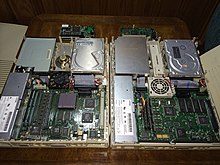Macintosh LC
The Macintosh LC (LC - low-cost color - inexpensive, color-capable) stood at the beginning of the product family for home users brought onto the market by Apple in the 1990s . It was built and sold between October 15, 1990 to March 23, 1992. The price was deliberately set low in order to reach customers who had not previously used an Apple Macintosh and who could use the device for e.g. B. to make private users, pupils and students interesting. In fact, sales were boosted enormously in 1990.
Together with the Macintosh IIsi , the Macintosh LC was the first Macintosh with an integrated audio input. In the years that followed, the name "LC" stood for a whole line of computers for private users.
For the Macintosh LC, Apple used a very flat case, which earned it the nickname " pizza box ", which fit exactly under Apple's 12 "and 13" monitors. The interior offered just enough space for a 3.5 ″ floppy disk drive and a half-height hard disk . Early models were also delivered with two floppy drives and without a hard drive. About the motherboard with built since 1984 Motorola 68020 - processor , which was clocked at 16 MHz, only one expansion board took place - the expandability of the computer was so severely limited. The Macintosh LC did not have a math coprocessor . The 16-bit wide data bus and the maximum memory expansion of 10 MByte RAM (delivered with 2 MByte RAM on the motherboard) limited the performance of the computer.
Otherwise, the interfaces established in the Mac environment were integrated, i.e. the usual two serial interfaces for modem and printer connection (also as network port for LocalTalk ), audio input and output, a SCSI interface for external peripheral devices such as e.g. B. Removable disk drives , an integrated graphics card with its own memory, Apple Desktop Bus for keyboard and mouse.
The maintenance friendliness of the computer was known, the case of which could be opened without loosening screws. All components, including the power supply unit and motherboard, are held in place by clips without screws.
The Macintosh LC was delivered with the MacOS 6.0.7 operating system and 256 kByte video RAM. With a screen resolution of 512 × 384 pixels, 256 colors could be displayed, with 640 × 480 pixels only 16 colors. When the video RAM was upgraded to 512 kByte, the palette was expanded to 32,768 colors (512 × 384 pixels). Apple offered a 12 ″ fixed frequency monitor especially for the Macintosh LC, which could only display a resolution of 512 × 384 pixels.
Even without NuBus slots, there were a number of expansion cards for the Processor Direct Slot (PDS) of the Macintosh LC. It was originally intended to accommodate an Apple IIe emulation card and was intended to replace the Apple IIe, which was widely used in schools and universities. A number of accelerator cards, network cards and graphics cards have been developed by third parties for the PDS of the Macintosh LC. Ethernet cards for the PDS were equipped with their own ROM so that these cards can be integrated into the MacOS without their own drivers. Upgrading with a Motorola 68882 math coprocessor as a PDS expansion card was also very popular .
The Macintosh LC sold well and was replaced in 1992 by the Macintosh LC II with a Motorola 68030 processor. The name "LC" was later used by Apple for PowerPC models and only disappeared from the range with the introduction of the iMac .
System profile
Macintosh LC ("pizza box", first model of a new series of inexpensive computers)
- Construction time: October 15, 1990 to March 23, 1992
- Classification: 32-bit Macintosh
- Main processor: Motorola MC68020
- Mass storage: 3.5 ″ drive for 1.44 MB floppy disks
- Clock rate: 16 MHz
- Main memory: 4 MB
- Max. RAM: 10 MB
- Graphics: 640 × 480 with 8-bit color depth
- Sound: built-in 8-bit mono system

